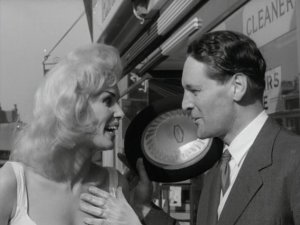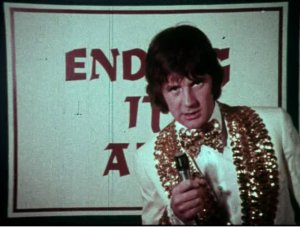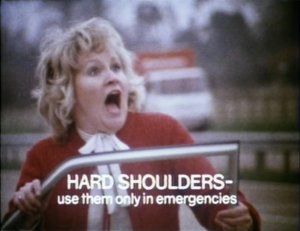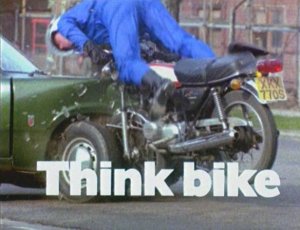The Good Old Days? - Road Safety (Part 1; Think Once, Think Twice...Think Don't Drive Your Car on the Pavement)
Welcome, readers, to another of my irregular columns. This one allows me to tackle my interest in social history, as it's clear to me that, to really understand a country, you should make some effort to learn about the day-to-day concerns of its citizens over the past century. In the case of Britain, we have a goldmine of information produced by successive governments, firmly entrenching our tradition of being told NOT TO BE SILLY by the Ministry of Information (MoI) during the Second World War, and the Central Office of Information (COI) after the war. At first, cinematic distribution through the Crown Film Unit was the main medium of communication (the PIF 'Shown By Request' is a great explanation of this process), but the COI focused on TV distribution from the mid-1950s as the new medium became popular, meaning PIFs became shorter to fit the demands of TV production. This entry deals with road safety, a subject often used by detractors to claim that the UK government is over-cautious with British drivers. I'll be interested to know if they continue to hold that opinion if a relative of theirs is killed or maimed on the roads (this hasn't happened to me, incidentally). Anyway, read on and wonder how the hell anyone managed to survive in an era of deadly glass windscreens and drivers gladly having 'one for the road'. Shudder...
Let's begin at the beginning, shall we? Dates are often approximate, because 'Charley Says Vol 2' doesn't have any dates, unlike the first volume. BAH. A release with both volumes can be bought here, and it's highly recommended. As so many PIFs in the collections concern themselves with road safety, I've split this article into two. Yes folks, there's more to come! Let's focus on PIFs for motorists for now. Links are provided to the PIFs on YouTube where possible; please let me know if you find ones I haven't.
Stored for the Duration (40s)
Although it seems bizarre to modern eyes, it seems like cars back in the 40s really were put away for years at a time, without the owners bothering to get faults fixed, or checking that their cars were road-worthy before taking them out again. The background to this warning from a ghost of a driver who forgot his brakes were broken when he put the car away was probably related to World War Two. Petrol was rationed throughout the war to 1950, and it is likely that people put their car away, rather than struggling with limited amounts of petrol. Thankfully, the MOT test, better cars and better drivers mean that this bloody terrifying scenario is extremely unlikely today.
MOT Road Test (1960)
A new concept when this was made (I really wouldn't have liked to be on the roads in the 1930s, 40s and 50s), it was required for cars over 10 (TEN) years old. It is now compulsory for cars over 3 years old, and your car can't be taxed without it if it falls under this law. The PIF gives an air of suggestion rather than compulsion, amusingly, but it isn't quite so funny to think that there is an increasing number of motorists nowadays who don't seem to see the need to have this test.
Russian Roulette/Beware of Weaving/The Way Ahead (50s/60s)
What seems like the obvious danger of overtaking without care nowadays, clearly was a very real issue back when there was a generation of drivers unused to heavier traffic. A bit scary, frankly.
 |
Olde Worlde Charm (50s)
Oh dear. Oh dear, oh dear, oh dear. This PIF is so hilarious, it probably deserves an article of its very own. On first showing, myself and my significant other thought it was condemning the rudeness of the man in the film, who is very polite when he bumps into an attractive woman on the street, but who has some choice words to say when the same woman turns at a junction in her car without indicating. However, on subsequent viewings, the terrible truth emerged; it's the WOMAN who is the real villain of the piece. Whilst the voiceover congratulates the man on his 'olde worlde charm' on the street and wryly comments on his attitude whilst in his car, it then firmly turns the blame on the woman, pointing out her failure to look in her mirrors (she's using them to plump up her hair), and failure to indicate her intentions. This being the Fifties, they can't resist rewinding the film to 'try again', as it is their one special effect, and then we see the same woman, now turning at the junction correctly. The man thinks to himself "Good driver, that girl. Attractive, too." No wonder the Womens' Lib movement told men what they could do with their 'olde-worlde charm'. It's a sign of just how far we've progressed that me and my (male) other half were unable to understand what was probably a clear enough message when it was made.
Jimmy Hanley - Getting Home Safely/Going On Holiday/Setting Out (50s)
Jimmy Hanley tells motorists that having a family is a responsibility, and that they should check that their brakes, lights and steering before setting out to keep them all safe. The very existence of these PIFs seems to suggest that motorists weren't always that responsible!
Rude On the Road (1959)/Road Hog - Don't Be Rude On the Roads (1960)
Stop sniggering, boy. This rather quaint call for road users to treat each other with courtesy and respect gives the lie to the idea that there was some 'golden age' of polite behaviour. Humans have ALWAYS been arseholes to each other.
Losing Your Driving License (60s)
The indignant "Why isn't something done?" suggests that not much action was taken against bad drivers until 1962. Erk. Mind you, although licenses were introduced in 1934, they were suspended during the Second World War and during 1956 due to the Suez Crisis, so perhaps we shouldn't be surprised that the government didn't get their act together until then. Of course, this means that there's quite a few elderly drivers in the UK that didn't take a driving test, including my grandad. Yes, it DOES show.
Dinosaur (1967)
Talking of elderly drivers, this PIF addresses those in the audience who have been driving for a while and assume that their experience outclasses newly qualified drivers. It doesn't, especially in an era which saw many new road signs introduced, and the PIF tells these 'dinosaurs' to learn these new signs to 'keep up with the kids'. Not particularly tactful...
 |
Don't Overcrowd Your Car (60s)
A rare thing for a PIF; it is filmed in a very arty fashion, with a contemporary song warning young people against the dangers of overcrowding their cars with all their mates. Compulsory seat-belt laws thankfully mean that this film can be enjoyed for its artistic value, as its message is out of date.
Wear A Helmet/Motorcycle Fashion Show/Always Wear a Safety Helmet (60s)
Of course, it may well have been the case that young women in the 60s didn't want to wear helmets whilst riding pillion for fear of messing up their hair. However, was there any need to have such a staged conversation between the two nice RADA girls in 'Wear A Helmet'? "You must admit, it looks...attractive...". Uh-huh. Still, Motorcycle Fashion Show does at least have a more convincing message. Groovy gear, baby.
If You Drink, Don't Drive (60s)/Don't Take Your Car for a Drink (70s)/Don't Ask a Man to Drink and Drive (60s)
It took about 30 years to get this message well and truly across; the campaign started in 1964, and by the time I was old enough to drive in the mid-90s, drinking and driving made you a social pariah. The role of women in persuading men to drive after drinking obviously became less important when they became more trusted behind a wheel of a car, although it's interesting to note that men were the main focus for all these campaigns up until the 80s. We must thank Barbara Castle for introducing the breathalyser (and seat belts), a measure that even her fiercest critics ended up admitting did the country an awful lot of good. That woman had balls. Even so, it's worth observing that seat belts in the front of cars wasn't made law until 1983, and wasn't made compulsory in the back of cars for adults until 1991.
Check Four for Safety - Motorists and Motorcyclists/Tyre Maintenance/Use Your Head - Breakdowns (60s)
Points out that you should check oil and water levels before setting out, and that old cars should not be raced at high speeds, citing 3,500 breakdowns in one year on the M1. Nowadays, it is unlikely that many cars will be 'past their best' without some considerable work being done at the MOT, and modern engines are considerably more reliable, meaning that a check of oil, water and tyre pressures can be far more occasional. Well, that's what I tell myself, anyway...
 |
Ending It All/Breaking In the Wet (70s)
A rather clever PIF starring Michael Palin using silent film cards to 'not recommend' methods of suicide before stating that driving close in the wet is the tried and tested method of 'ending it all'. "Breaking In the Wet" gives the message more directly. And drivers still haven't learned...
Joining The Motorway/Leaving The Motorway (70s)
Advice on what was clearly a frightening experience for early motorway drivers. Due to the increased use of motorways and the 'Pass Plus' motorway training certificate, you rarely see drivers balls this up nowadays.
Overtaking Only (70s)
Seeking to dispel the myth that there is a 'fast lane' on a motorway, an idea that comes from the early days of motorways. This is one campaign that hasn't worked! To bring this up-to-date, here's a great film with John Stapleton about that modern bugbear of hogging the middle lane on motorways. Incidentally, I think John is standing at Junction 8 of the M5 at the beginning, just before the turnoff for Strensham services.
Driver Fatigue (70s)
Road signs informing drivers that 'tiredness kills' suggests this is still a big problem. Nowadays, having a small nap is also advised, as well as opening a window, turning on the radio and turning off for a coffee. Our increasingly car-dependent society means that this problem hasn't gone away; the most famous case is the 2001 Selby rail crash, in which 10 people died when Gary Hart lost control after falling asleep on the M62, sending his car onto a rail track. A passenger train collided with it, sending it into the path of a freight train coming in the other direction. 10 people were killed and 70 injured, but, amazingly, Hart was unharmed, and was sentenced to 5 years for dangerous driving. It's not big or clever, folks.
Driving in Fog is Dangerous (70s)
Despite many campaigns (old PIFs of this type are still shown late at night in foggy weather), drivers still seem to think they can drive normally in low visibility, the bloody idiots.
Motorway Signals (70s)
Made to introduce the new matrix signals still widely in use today, these no doubt saved many lives by warning drivers of hazardous conditions ahead.
Open Your Eyes - You Could be Next! (70s)
As this Northern Ireland PIF informs us, people in the province were twice as likely to be killed on the roads there than in the rest of the United Kingdom; clearly, drastic action was needed. This PIF gets locals on board by talking about the beauty of the area, but then interviews a characteristically stern nurse and policeman to get the message over.
Radial and Crossply Mix (70s)
Now only radial tyres are commonly used, but it seems it was frighteningly easy to get yourself in trouble with these two types of tyres. This link from RoSPA explains the reason why cross-ply and radial need to be mixed with great care, if you really insist on doing so. There's two edits of this PIF, with Radial and Crossply Mix featuring an Igor-type figure and a mad scientist, and one that just uses the stunt on its own.
 |
Hard Shoulders (70s)
Amusing appearance of Neil Innes and Michelle Dotrice in a PIF warning that stopping on a hard shoulder is dangerous, and should only be done in emergencies. On the M42, there is now a system using variable speed limits and opening up the hard shoulder in congested conditions to ease delays. Although this is a generally sound idea, great care should be taken to ensure that the general message isn't diluted. The learner moped driver I saw using the hard shoulder on the M5 recently shows that not everyone seems to understand motorway rules; that rider was breaking 3 rules all at once!
Jo and Petunia - Worn Tyres (1973)
Jo and Petunia were used for a few years as the standard morons who showed you exactly how NOT to behave. This PIF kills them off, when Jo lets their car tyres get worn and they skid off the road into a tree. Petunia's warped expression as they skid is really quite distrubing, and there's a nice transition to live-action at the end.
Junction Lanes (1974)
Don't weave between lanes. This light-hearted PIF shows you why, with a son writing off his dad's motor because he's misunderstood the art of getting in the correct lane.
Caravan Instability (1976)
This should really be 'Caravan Stupidity'. Arthur Lowe provides the disgruntled voice of Claude, a caravan which has been overloaded, with most of the weight shifted to the front when the driver has to break suddenly. Inevitably, when the driver exceeds the speed limit, the caravan veers off to the side, leading to a crash. I've never really understood why some drivers feel so happy with pulling a heavy load behind them; the number of caravan drivers on the hard shoulder of the M5 in the summer suggests that this PIF needs to be shown again, and often. Motorhomes are a safer bet, really.
Clunk Click - Shopping (1972)
A memorable PIF made to appeal to women's perceived vanity, with Jimmy Saville pointing out that car accidents happen to women too (almost gleefully, in fact), and that your face might get all smashed up. So, wear your seat belt. And a reinforced face mask.
Seatbelts Launch/Progress/Success - Shaw Taylor (1972)
An intriguing campaign, shown in the Tyne Tees area only, where Shaw Taylor (then presenter of the long-running Police 5) encouraged drivers in Newcastle to wear seat belts, emphasising that many drivers would have had families dependent on them getting home safely. Each of the three PIFs ends with the slogan 'Your seat belt is their security', and Shaw signs off his first PIF with the phrase "See ya, Clunk-Clicker". Quite.
Billy Blunders/Mr Blunders/Mrs Blunders (1976)
Horray! These are great PIFs, featuring the iconic Bill Maynard (Edit; I've been told that this is actually Ivor Salter, but I can't find anything to confirm this, sadly), which warn 'Beware of the Blunders'. You may be a good driver, but you can't vouch for other drivers, so wear your seat belt. These three PIFs, along with the Jimmy Saville and Shaw Taylor PIFs above, were part of the 'Clunk, Click' campaign which preceded the law making it mandatory to wear seat belts in 1983 and 1991. The earliest PIF on 'Charley Says' to mention seat belts was made in 1967, which is a sobering thought when you consider that the first motorway in Britain was opened in 1961. Yikes.
 |
Think Bike - Edward Judd (1975)/Think Bike - Jimmy Hill (1978)
Edward Judd's PIF was parodied in 'The Young Ones', where his phrase of "Think once, think twice, Think Bike" was changed to "Think once, think twice, think don't drive your car on the pavement". Jimmy Hill's PIF starts with a nasty collision between a motorcyclist and motorist. I challenge you not to laugh when there's a cut to Jimmy turning from a monitor saying the phrase "A tragic, needless accident.". It's almost as if he's been waiting for one all evening. The Think campaign has been resurrected in recent years to cover most aspects of driving.
The Young Ones parody has soft foodstuffs in it, suggesting that it's being confused in part with the PIF 'Peach and Hammer - Old Man', which, unsurprisingly, has a hammer slamming into a peach to emphasise the difference in vulnerability between a human and a car. Given that this PIF dates from 1976, it's possible that the two were shown around the same time, and of course the writers of 'The Young Ones' didn't have a handy DVD collection to check. It's ok. You can wake up now.
Traffic Shapes (1980) A very well-designed PIF to advertise the red triangle signs meaning 'Beware' and the red circle signs meaning 'No', with Richard Briers as one of the voiceovers.
Space Invader (1982) Yes, the COI are on the ball. This is actually a nice attempt to explain why you should leave enough space between you and the driver in front, and that, erm, it's not a game you can win.
The moral of all this? People are stupid. They're really, really, REALLY stupid, and the statistics around road safety show that protecting people from themselves isn't 'nannying', it's essential to reduce deaths and injuries. There's still more to be done if Britain is to keep its reputation as having the safest roads in Europe, and if that means pissing off motorists, then that's a good thing. There's really no harm in reminding people that they're driving a big hunk of metal at speeds that aren't friendly to the human body, and that to do so as safely as possible requires a little responsibility.
More information on UK road safety can be found at the Highways Agency, the UK Department for Transport, and the rather excellent Public TV.
About this entry
- By Tanya Jones
- Posted on Saturday, January 19 2008 @ 10:17 pm
- Categorised in TV, Analysis
- Tagged with PIF
- 10 comments

Hooray, excellent article.
By Ian Symes
January 19, 2008 @ 11:46 pm
reply / #
Wow Tanya. I'm speechless!
And I'll get back to the article during lunchbreak so I can read it thoroughly...
By Marleen
January 21, 2008 @ 10:12 am
reply / #
*blushes* Ta!
By Tanya Jones
January 21, 2008 @ 3:41 pm
reply / #
The crash in the Edward Judd one is quite brutal. They'd never get away with showing that now. What they like to do now is show anything but the crash, probably because they know how many crazy people get a buzz off seeing crashes due to shows like 'Let's Have A Look At What This Idiot Did...In America!' glamourising them.
By performingmonkey
January 21, 2008 @ 4:32 pm
reply / #
Like these ones, you mean?
http://www.youtube.com/watch?v=YqOe4w1cvQc
http://www.youtube.com/watch?v=ipnJbSnmc24
http://www.youtube.com/watch?v=zWvNeJXE_cY
If anything, the Government now have to up the ante, because viewers are now used to sophisticated crash scenes. Note PIFs before the 90s were pretty short on blood, and now it's everywhere.
By Tanya Jones
January 21, 2008 @ 10:04 pm
reply / #
Oooookay... I just got to the Space Invaders one... and all I can say is... hahahahahaha! Brilliant. It's a super advert.
By Marleen
January 21, 2008 @ 10:54 pm
reply / #
The COI seemed to be obsessed with using computer games to 'reach out' to Ver Kidz in the early Eighties. Just look at this 'Say NO to Strangers' film from 1981; http://www.youtube.com/watch?v=QK8ZOiDyINk
By Tanya Jones
January 22, 2008 @ 8:52 am
reply / #
I remember well Jimmy Saville’s “Clunk Click” adverts,and the “Beware of the Blunders” ones. In between there came what might be called the ‘analogy’ ones.
In one of them, we see a man climbing into a cannon and then fired out. The voiceover says “Would you be prepared to be a human cannonball? Would you be prepared to fired at 30 miles per hour, head first, into a sheet of glass?” As the cannon is fired, the voiceover says “You wouldnt’? Then never leave your seat belt off when driving round town, and we cut to another man driving a car. Suddenly he grimaces and starts to swerve (we are not shown what he’s trying to avoid) but nonetheless he crashes (into what - again we do not see) and the man is thrown forward. Then we cut back to the human cannonball going though the glass, and then the driver going through the windscreen, and the pay off “Clunk click even on the shortest trips”
In another of these ads, a man is seen wanting to jump off a building. In a courtyard below there is a glass roof, and also a crowd yelling “Don’t do it!” We then see another man climbing some steps onto the roof (to try and talk the other man down perhaps?) and then he says to camera “I don’t know what all the fuss is about. taking a short trip round town without a seat belt can be just as risky. It can you know. If you had a crash at only 30 miles an hour (quick cut to a car speedometer showing 30mph) and you did’nt have a seat belt to restain you, you’re liable to go through the windscreen with the same force as if you dived, headfirst, through that glass roof thirty feet below. Anyone who thinks its mad to take a risk like this, must think its mad to drive round town without a seat belt on”. All the while the crowd are still shouting “Don’t do it!”
As in the other ad, we cut to a man driving a car, still hearing the crowd “Don’t do it!” and also a woman driving another car. The man swervers and crashes: I don’t remember quite what happens with the woman (persumably she crashes as well), the man goes through the windscreen, we see the woman still in her seat (I guess she was wearing a seat belt). Again we finish with “Clunk click, even on the shortest trips”
By Douglas from Reading
March 09, 2009 @ 5:24 pm
reply / #
Thanks Douglas; are these on YouTube? I’d love to see them.
By Tanya Jones
March 12, 2009 @ 2:03 pm
reply / #
Couldn’t find them on YouTube unfortunately. One other thing about these ‘analogy’ ads: the men who went through the windscreen were smartly dressed in suits and ties, as was the unfortunate victim of Mrs Blunders. Important day when you die: need to look your best for it!
By spoogie
March 24, 2009 @ 7:42 pm
reply / #